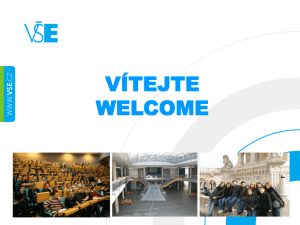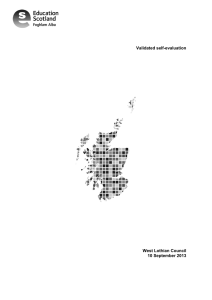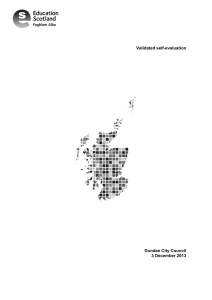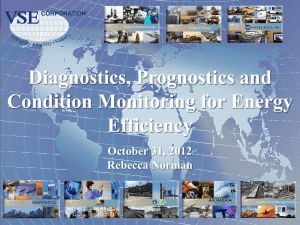REGIONAL ELECTRICITY COMPANY VSE a.s. ITS TASK AND
advertisement
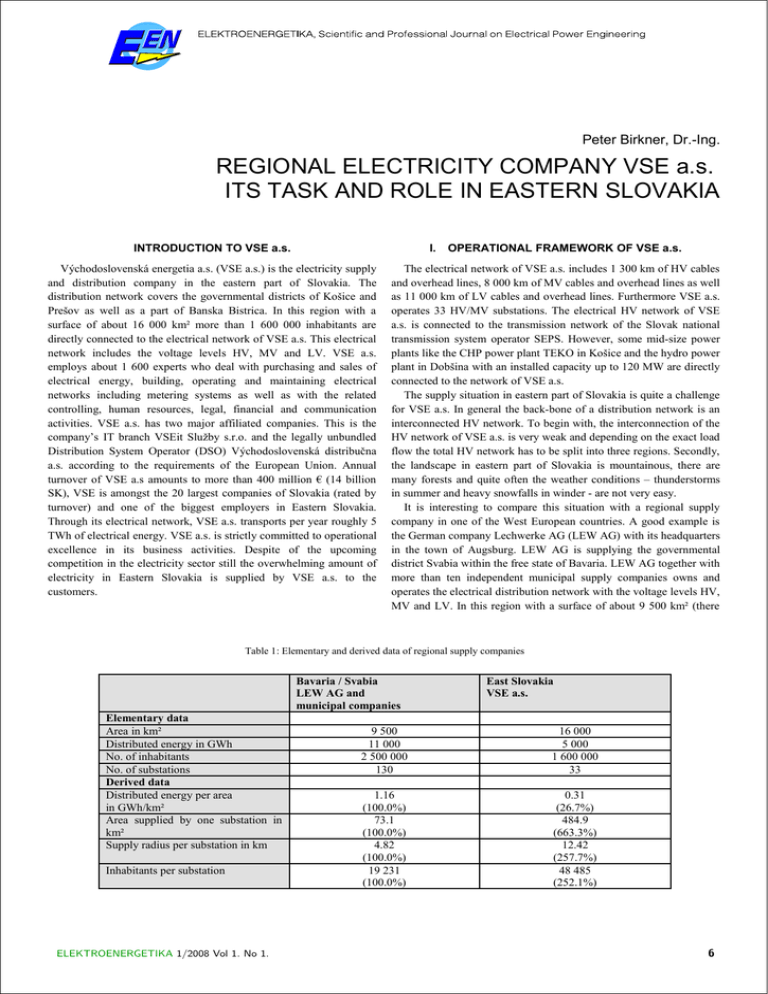
Peter Birkner, Dr.-Ing. REGIONAL ELECTRICITY COMPANY VSE a.s. ITS TASK AND ROLE IN EASTERN SLOVAKIA INTRODUCTION TO VSE a.s. I. Východoslovenská energetia a.s. (VSE a.s.) is the electricity supply and distribution company in the eastern part of Slovakia. The distribution network covers the governmental districts of Košice and Prešov as well as a part of Banska Bistrica. In this region with a surface of about 16 000 km² more than 1 600 000 inhabitants are directly connected to the electrical network of VSE a.s. This electrical network includes the voltage levels HV, MV and LV. VSE a.s. employs about 1 600 experts who deal with purchasing and sales of electrical energy, building, operating and maintaining electrical networks including metering systems as well as with the related controlling, human resources, legal, financial and communication activities. VSE a.s. has two major affiliated companies. This is the company’s IT branch VSEit Služby s.r.o. and the legally unbundled Distribution System Operator (DSO) Východoslovenská distribučna a.s. according to the requirements of the European Union. Annual turnover of VSE a.s amounts to more than 400 million € (14 billion SK), VSE is amongst the 20 largest companies of Slovakia (rated by turnover) and one of the biggest employers in Eastern Slovakia. Through its electrical network, VSE a.s. transports per year roughly 5 TWh of electrical energy. VSE a.s. is strictly committed to operational excellence in its business activities. Despite of the upcoming competition in the electricity sector still the overwhelming amount of electricity in Eastern Slovakia is supplied by VSE a.s. to the customers. OPERATIONAL FRAMEWORK OF VSE a.s. The electrical network of VSE a.s. includes 1 300 km of HV cables and overhead lines, 8 000 km of MV cables and overhead lines as well as 11 000 km of LV cables and overhead lines. Furthermore VSE a.s. operates 33 HV/MV substations. The electrical HV network of VSE a.s. is connected to the transmission network of the Slovak national transmission system operator SEPS. However, some mid-size power plants like the CHP power plant TEKO in Košice and the hydro power plant in Dobšina with an installed capacity up to 120 MW are directly connected to the network of VSE a.s. The supply situation in eastern part of Slovakia is quite a challenge for VSE a.s. In general the back-bone of a distribution network is an interconnected HV network. To begin with, the interconnection of the HV network of VSE a.s. is very weak and depending on the exact load flow the total HV network has to be split into three regions. Secondly, the landscape in eastern part of Slovakia is mountainous, there are many forests and quite often the weather conditions – thunderstorms in summer and heavy snowfalls in winder - are not very easy. It is interesting to compare this situation with a regional supply company in one of the West European countries. A good example is the German company Lechwerke AG (LEW AG) with its headquarters in the town of Augsburg. LEW AG is supplying the governmental district Svabia within the free state of Bavaria. LEW AG together with more than ten independent municipal supply companies owns and operates the electrical distribution network with the voltage levels HV, MV and LV. In this region with a surface of about 9 500 km² (there Table 1: Elementary and derived data of regional supply companies Bavaria / Svabia LEW AG and municipal companies Elementary data Area in km² Distributed energy in GWh No. of inhabitants No. of substations Derived data Distributed energy per area in GWh/km² Area supplied by one substation in km² Supply radius per substation in km Inhabitants per substation ELEKTROENERGETIKA 1/2008 Vol 1. No 1. East Slovakia VSE a.s. 9 500 11 000 2 500 000 130 16 000 5 000 1 600 000 33 1.16 (100.0%) 73.1 (100.0%) 4.82 (100.0%) 19 231 (100.0%) 0.31 (26.7%) 484.9 (663.3%) 12.42 (257.7%) 48 485 (252.1%) 6 off 7 500 km² directly supplied by LEW AG) more than 2 500 000 inhabitants are living. The landscape is hilly and covered with forests. LEW AG and the sub-supplying municipal companies operate together about 130 HV/MV substations. Total public consumption of this region amounts to some 11 TWh. Table 1 shows characteristic ratios between supplied area, distributed energy, number of substations and number of inhabitants. As a result of Table 1 the very different supply situations of the two companies are clearly demonstrated. In Svabia a four times higher number of substations is operated in an area which covers about 60% of the supply area of VSE a.s. Subsequently, there are substantial differences in the factors “supply area per substation” (in East Slovakia 6.6 times higher) and “supply radius per substation” (in East Slovakia 2.6 times higher). This has a significant impact on the existing network structure as well as on the network extension and operation philosophy. The MV network in East Slovakia is much more extended than in Svabia. This could be one reason that the voltage level in Slovakia amounts to 22 kV compared to 20 kV in Bavaria. Furthermore the MV network in Slovakia is characterized by overhead lines where as in Svabia the ration between underground cables and overhead lines is about 1:1. More overhead lines, more extended mains and more difficult terrain leads logically to more outages. In addition, the age structure of the assets in East Slovakia is much less favorable than in Svabia. This again contributes to an increase of the outage frequency. Finally, the large extension of MV network and the less developed traffic infrastructure in East Slovakia also requests longer re-supply times compared to Svabia. In addition to unplanned outages there are also a significant number of planned ones. The intensive renewal program of VSE a.s. and the weakly interconnected MV network where very often there is no open loop design request also planned outages quite frequently. In total the system average interruption duration index (SAIDI) amounts in East Slovakia up to roughly 400 min/yr while LEW shows some 40 min/yr. II. MAIN CHALLENGES FOR VSE a.s. Current main challenge of VSE a.s. is to improve the technical quality of the electrical network and to put SAIDI closer to the West European average of about 100 min/yr. Above all, this is necessary in order to offer the new investors coming from Western Europe an attractive technical business environment. High quality and reliable supply with electricity is a prerequisite for the decision to invest in a specific region. Extending the capacity of the network and starting a renewal program requires high capital expenditure. Of course, this means an increase of the investment budget but also an improvement of the internal processes and the workflow. The first step which had been done during the years 2005 and 2006 was to introduce a process oriented organizational structure. Today each employee in the technical division of VSE a.s. has a more than 50% higher contribution to the success of the company compared to the year 2004. At the moment VSE a.s. is improving the asset database in order to get better knowledge on the asset condition but also on the impact of individual assets on the overall reliability of the electrical network. In addition VSE a.s. is heavily working on the improvement of the remote control system (e.g. modern control room but also connection of substations and MV sectionalizers to the remote control system) as well as on the extension of the automated meter reading system. ELEKTROENERGETIKA 1/2008 Vol 1. No 1. Adequate personal safety equipment, modern cars, platforms and trucks, mobile generators and MV/LV transformer stations but also using technologies like 22 kV life line work complete the current activities. In order to put it into a slogan, VSE a.s. is heading for setting the right priorities, automating the electrical network, optimizing the equipment and achieving operational excellence. The program for putting the network of Eastern Slovakia to a West European level will take about five to ten years. In order to keep the current high level of investments which is above depreciation a stable regulatory framework that secures revenues and thus free cash flow is indispensable. Above all, it will be a challenge for the regulator and the energy policy to find the right balance between the needs of the distribution system operators but also the needs of private, commercial and industrial customers who are requesting socially acceptable and economically reasonable electricity prices. In this respect, special attention has to be given to the non liquid Slovak electricity market where prices increased tremendously during the last few years. Nevertheless, an electrical network respecting the principles and activities set up by VSE a.s. and which is able to distribute a given amount of electrical energy with a minimum volume of assets can give a strong contribution in order to achieve the balance mentioned before. Concerning challenges of VSE a.s. also energy procurement, marketing and sales activities have to be mentioned. Even if this paper is focusing on network business and even if network business is contributing with about 85% to the current profit of VSE a.s. this activity is the second business pillar. Here, the recently liberalized market creates new demands, asks for new strategies, requests additional competencies and triggers off the establishment of new types of information systems. III. VSE a.s. AND THE REGION OF EASTERN SLOVAKIA The intension of VSE a.s. is to be a valuable partner for the region of Eastern Slovakia. The first and foremost task of VSE a.s. is to provide a secure and economical supply with electrical energy to household, commercial and industrial customers. This protects the inhabitants and attracts investors. As a result VSE a.s. contributes to welfare and employment within the East Slovak region. It is obvious that in this respect VSE a.s. closely cooperates with the independent regions of Košice and Prešov as well as with the municipalities in order to develop the region. In addition, VSE a.s. itself offers about 1 600 qualified, attractive and secure jobs even in regions with still a high unemployment rate. VSE a.s. is one of the biggest investors in the region and due to this VSE a.s. also gives work to many regional companies and subsuppliers. Sponsoring of regional activities concerning education, culture, environment and sports, paying a substantial amount of taxes and providing 51% of the profit to the national property fund are other positive contributions of VSE a.s. Voluntary engagements of VSE a.s. employees within regional projects e.g. the recent establishment of a nature trail together with the state forest administration are another positive element of the activities of VSE a.s. Finally, VSE a.s. is strongly dedicated to renewable energy sources. VSE a.s. not only takes the electricity of numerous private renewable power plants but also is actively involved especially in bio mass and bio gas projects. 7 IV. CONCLUSIONS Modern distribution business means above all taking responsibility for the positive development of region. Electricity is a crucial element of the modern infrastructure and thus is a prerequisite for sustainable development of the inhabitants’ welfare and economic growth. VSE a.s. recognizes this responsibility and is convinced to provide the right answers with respect to the challenges linked to the electricity business in Eastern Slovakia BIBLIOGRAPHY energetika a.s., Slovakia. Lechwerke AG as well as Východoslovenská energetika a.s. are members of RWE Energy Group which is the downstream branch of RWE (network and energy sales) in Central Europe. Dr. Birkner is member of the European Electricity Associations EURELECTRIC (Vice Chairman of Networks Committee) and CIGRE (Member of German Committee). He has authored and coauthored more than 20 technical papers and also has taught numerous courses on the impact of deregulation on utilities in Austria, Germany and Switzerland. Currently he holds the position of a Visiting Professor at Technical University of Košice. Dr.-Ing. Peter Birkner received his Diploma in Electrical Engineering and his PhD Degree from Technical University Munich, Germany. For 17 years he worked for Lechwerke AG, Germany, on a variety of subjects concerning distribution systems with voltages from 0.4 kV up to 110 kV. His position was Vice-President and Director of business unit “Distribution System Operation” which included the responsibility for geographic information system, strategic network design, asset management strategies, service quality, protective devices, control and dispatching room, metering services and implementation of third party access to the distribution network. In 2005 Dr. Birkner was appointed Member of Board and Executive Director of Východoslovenská ELEKTROENERGETIKA 1/2008 Vol 1. No 1. 8

